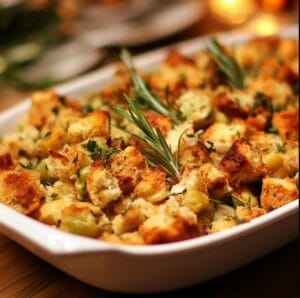Introduction
Many people use the terms stuffing and dressing interchangeably, but these dishes have distinct differences in preparation, ingredients, and cultural roots. If you’ve ever wondered, what is the difference between stuffing and dressing, this guide will walk you through everything you need to know. From their histories to how they’re prepared today, you’ll gain a clear understanding of these comforting, flavorful side dishes.
What Is the Difference Between Stuffing and Dressing?
At its core, the primary difference lies in where and how these dishes are cooked.
- Stuffing is cooked inside poultry, absorbing the juices and flavors during roasting.
- Dressing, on the other hand, is cooked separately in a baking dish, resulting in a crispier texture.
While both share similar ingredients like bread, vegetables, and seasonings, their cooking methods set them apart. In addition, stuffing is often associated with northern regions of the United States, while dressing is a term commonly used in the South.
Key Ingredients Shared by Stuffing and Dressing
Both dishes rely on a few core ingredients:
- Bread: Cubed white bread, cornbread, or sourdough is used as a base.
- Aromatics: Celery, onions, and garlic provide flavor and fragrance.
- Herbs: Sage, thyme, and parsley are staples for seasoning.
- Moisture: Chicken broth or vegetable stock is used to bind the ingredients.
The choice of additional ingredients, such as sausage, nuts, or dried fruit, often depends on regional or personal preferences.
A Brief History of Stuffing and Dressing
Origins of Stuffing
Stuffing has ancient roots, dating back to Roman times when cooks used it to fill birds, fish, and even vegetables. Its purpose was to enhance flavor and prevent the meat from drying out during cooking.
The Emergence of Dressing
Dressing became popular in the American South, where it was cooked outside the bird due to health and safety concerns. Cornbread dressing, in particular, became a regional favorite.
Regional Differences in Terminology
The terms “stuffing” and “dressing” are often determined by geography:
- In northern states, “stuffing” is the preferred term regardless of how it’s cooked.
- In southern states, “dressing” is used, even for recipes that involve stuffing poultry.
These linguistic preferences highlight the cultural diversity of American cuisine.
How Stuffing and Dressing Are Prepared
Stuffing
- Prepared by mixing bread, vegetables, and seasonings.
- Stuffed inside poultry and roasted.
- Absorbs the natural juices of the bird, resulting in a moist texture.
Dressing
- Mixed similarly but baked in a separate dish.
- Achieves a crispier texture on top while remaining moist inside.
- Easier to control flavor and texture since it’s cooked independently.
What Are the Pros and Cons of Stuffing?
Pros:
- Absorbs flavorful juices from the bird.
- Adds moisture to the poultry as it cooks.
Cons:
- Requires careful cooking to ensure it reaches a safe internal temperature.
- Can result in uneven texture if not cooked properly.
What Are the Pros and Cons of Dressing?
Pros:
- Easy to control cooking time and texture.
- Reduces the risk of undercooked poultry.
Cons:
- Does not benefit from the natural flavors of the bird.
- May require more seasoning to enhance flavor.
How to Make Perfect Stuffing
- Prepare the Ingredients:
- Cube and dry bread in advance.
- Dice aromatics like onions and celery.
- Combine the Mixture:
- Mix bread, vegetables, herbs, and broth.
- Add optional ingredients like sausage or cranberries.
- Stuff the Bird:
- Loosely fill the cavity to allow for even cooking.
- Bake Until Done:
- Ensure the stuffing reaches an internal temperature of 165°F.
How to Make Perfect Dressing
- Toast the Bread:
- Dry or toast the bread for better absorption.
- Cook Aromatics:
- Sauté onions, celery, and garlic in butter.
- Mix and Bake:
- Combine all ingredients in a bowl and transfer to a greased dish.
- Bake at 350°F until golden and crispy on top.
Tips for Choosing Between Stuffing and Dressing
- Choose stuffing if you want to enhance the poultry’s flavor and enjoy a softer texture.
- Opt for dressing if you prefer crispy edges and easier preparation.
- Always consider food safety when stuffing poultry—use a thermometer to ensure proper cooking.
Healthier Alternatives for Stuffing and Dressing
- Replace white bread with whole-grain or gluten-free bread.
- Use low-sodium broth to reduce salt content.
- Add more vegetables like carrots, mushrooms, or kale for extra nutrients.
Common Mistakes to Avoid
- Over-Saturating the Bread:
- Too much liquid can make the dish soggy. Add broth gradually.
- Skipping Fresh Herbs:
- Dried herbs work, but fresh ones provide more vibrant flavor.
- Not Using a Thermometer:
- For stuffing, always check the internal temperature to ensure safety.
Serving Suggestions
- Serve stuffing or dressing alongside roast turkey, ham, or chicken.
- Pair with classic sides like mashed potatoes, green beans, or cranberry sauce.
- Add a drizzle of gravy for extra richness.
Storing and Reheating Leftovers
- Refrigeration:
- Store leftovers in an airtight container for up to 3 days.
- Freezing:
- Freeze dressing or stuffing for up to 3 months. Thaw overnight in the fridge before reheating.
- Reheating:
- Warm in the oven at 300°F, covered with foil to retain moisture.
What Is the Difference Between Stuffing and Dressing?
People often use the terms stuffing and dressing interchangeably, but distinct differences exist in their preparation and regional preferences. Knowing these nuances helps you choose the best option for your next meal or holiday gathering.
Preparation Differences:
- Cooks prepare stuffing inside the cavity of a turkey or chicken, where it absorbs the bird’s juices during roasting.
- Dressing bakes in a separate dish, creating a crispier texture on top.
Regional Preferences:
- In the Southern United States, people favor dressing, often made with cornbread.
- In Northern regions, stuffing takes precedence and commonly includes bread cubes along with extras like sausage or nuts.
Learn more about the components of traditional dressing by exploring what traditional dressing is made of.
Ingredients and Variations
Both dishes share many core ingredients, such as bread, broth, and seasonings like sage and thyme. However, the choice of bread (cornbread vs. white bread) and additional ingredients (like fruit or oysters) can vary widely.
Learn more about the base components of chicken dressing in this detailed guide.
Modern Takes
While traditional recipes hold strong, many modern versions of stuffing and dressing incorporate unique elements:
- Vegetarian versions with vegetable broth and mushrooms.
- Gluten-free options using gluten-free bread cubes.
- International influences with added spices or nuts.
For inspiration, try this classic chicken dressing recipe.
Final Thoughts
Whether you choose stuffing or dressing, both are delicious options that complement holiday meals beautifully. Understanding their differences allows you to pick the best version for your taste and occasion. For more recipes and tips, check trusted resources like The Kitchn or Bon Appétit.
Frequently Asked Questions
1. What Is the Difference Between Stuffing and Dressing?
Benefit: Understanding this difference allows you to choose the cooking method that best suits your taste preferences and ensures food safety when preparing poultry.
2. Is Dressing Healthier Than Stuffing?
Dressing offers a healthier option for several reasons. Cooking it separately prevents it from absorbing excess fat from the poultry, which helps reduce calorie content. Additionally, dressing offers more control over the ingredients, making it easier to adjust for dietary needs. For example, you can use whole-grain bread for more fiber or reduce sodium by using low-sodium broth.
Benefit: Opting for dressing lets you create a lighter version of this comforting dish without compromising on flavor.
3.Can You Make Stuffing and Dressing Ahead of Time?
Yes, you can prepare stuffing and dressing in advance to simplify holiday cooking and ensure a flavorful dish.
Steps to Prepare Ahead:
- Combine all ingredients for the stuffing or dressing in a baking dish.
- Cover the dish with foil to keep it fresh.
- Store the dish in the refrigerator for up to 24 hours before baking.
Why Prepare Ahead?
- Save Time: Focus on other dishes or enjoy more relaxation on the big day.
- Enhance Flavor: Letting the ingredients sit overnight deepens their taste.
- Increase Convenience: Baking a pre-assembled dish is quick and easy.
Tips for Success:
- Add more broth if the mixture feels dry after refrigeration.
- Extend the baking time by 10-15 minutes if starting with a cold dish.
4. What Type of Bread Is Best for Stuffing and Dressing?
The type of bread you select plays a crucial role, as it significantly impacts both the texture and flavor of the dish. White bread, sourdough, and cornbread are the most common choices. For a denser, more rustic stuffing or dressing, opt for artisan bread or whole-grain varieties. Drying or toasting the bread beforehand is crucial, as it allows the cubes to soak up the broth without becoming overly soggy.
Benefit: Selecting the right bread ensures your dish has the perfect balance of texture and flavor, tailored to your preferences.
5. How Can I Make My Stuffing or Dressing More Flavorful?
There are several ways to enhance the flavor:
- Use homemade or high-quality broth for depth.
- Sauté aromatics like onions, garlic, and celery in butter for a rich base.
- Add fresh herbs like sage, thyme, or rosemary for an aromatic touch.
- To add extra flavor and texture, consider experimenting with mix-ins such as sausage, dried cranberries, or toasted nuts, which can create a unique twist.
Benefit: Small tweaks can elevate your dish, turning a simple side into the star of the meal.

